September 21, 2012
Air Date: September 21, 2012
FULL SHOW
SEGMENTS

Pollutants Implicated in ADHD
View the page for this story
About one in every ten children in the United States has been diagnosed with ADHD. Now scientists at Laval University in Quebec say some environmental pollutants increase the incidence of attention problems. Dr. Gina Muckle tells host Steve Curwood about her study demonstrating an association between ADHD in children and exposure to lead and mercury. (06:45)

Heinz Environment Prize Winner
View the page for this story
Pediatrician Richard Jackson won this year’s Heinz Environment Prize. Dr. Jackson believes our built environment is one cause of rising rates of obesity and depression. He explains to host Steve Curwood about that better designed communities could improve public health. (06:25)

A Look Back at Rachel Carson
View the page for this story
Rachel Carson’s seminal book “Silent Spring” was published 50 years ago this month. That work made Rachel Carson a household name but her personal life was very private. A book of correspondence between Rachel Carson and her close friend, Dorothy Freeman, gave insight into Carson's convictions, and feelings. Host Steve Curwood spoke with the editor of "Always, Rachel", Dorothy Freeman's granddaughter Martha, about the genesis of "Silent Spring". (10:30)

“Silent Spring Turns” 50
View the page for this story
Rachel Carson's legacy includes the ban on pesticides like DDT in the United States but a cocktail of other dangerous chemicals is still in use. Frank Graham is an editor with the Audubon Society and author of a follow up to Carson’s work“Since Silent Spring”. Graham talks to host Steve Curwood about the use of pesticides in the US then and now. (05:55)
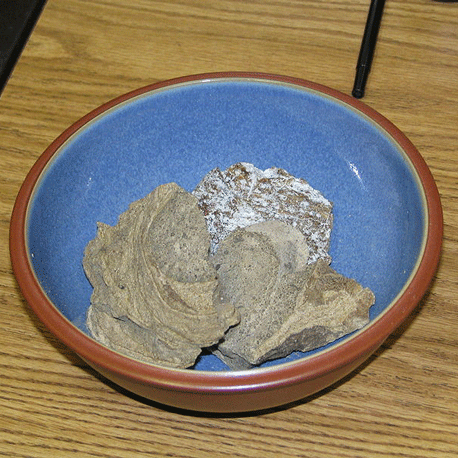
Science Note: Synthetic Ambergris
View the page for this story
Ambergris is regurgitated by Sperm whales and valued by perfumers. But natural ambergris could soon be replaced by a laboratory-made alternative. (01:50)
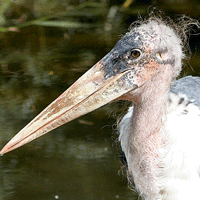
Marabou Stork
/ Ari Daniel ShapiroView the page for this story
Marabou Storks are large graceful birds, but Ugandans in Kampala see them as a menace. Uncollected garbage and slaughter-house refuse have led to a stork population explosion. Ari Daniel Shapiro reports that Ugandans are turning to desperate measures to get rid of the birds. (05:40)

Conservation Canine
View the page for this story
Scientists at the University of Washington are using rambunctious rescue dogs to track down endangered species in their natural habitat. The Conservation Canines work all over the world — tracking elephants in Africa and Orcas in the Pacific. Professor Samuel Wasser teells host Steve Curwood about their work chasing salamanders and in the controversial tar-sands area of Alberta. (09:25)
Show Credits and Funders
Show Transcript
HOST: Steve Curwood
GUESTS: Gina Muckle, Richard Jackson, Frank Graham, Samuel Wasser
REPORTERS: Mary Bates, Ari Daniel Shapiro
[THEME]
CURWOOD: From Public Radio International - this is Living on Earth. I'm Steve Curwood. New research connects attention deficit in children to mercury and lead exposure. Also – a winner of this year's Heinz environment prize claims we're fat and depressed because of how we designed our country:
JACKSON: As I look at how we've built America we've made it hard for people to be fit. Harder for people to get affordable healthy food and harder for us to connect with our families and with our communities.
CURWOOD: A new vision for our cities. And - a big beef with a big bird in Uganda - the Marabou stork:
TWANZA: Those are the droppings. So if you keep leaving your car under the shade, wanting to protect it from the sun, the Marabous will spoil it. And then when people are passing, it can drop on you also – on your clothes, in your hair.
CURWOOD: We'll have those stories and more this week, on Living on Earth. Stick Around!
[THEME]
ANNOUNCER: Support for Living on Earth comes from the National Science Foundation and Stoneyfield Farm.
Pollutants Implicated in ADHD

Dr. Gina Muckle
CURWOOD: From the Jennifer and Ted Stanley Studios in Boston, this is Living on Earth. I'm Steve Curwood. At least one in every ten school-aged children in the United States has been diagnosed with ADHD, and over the last decade, prescriptions for attention deficit medications are up nearly 50 percent.
There are many theories about the cause of the increase in ADHD, but scientists from Laval University in Quebec have new evidence implicating two notorious toxins. In a study just published in Environmental Health Perspectives they found an association between ADHD in children and exposure to mercury and lead.
Joining me from Quebec City is one of the study's authors, Dr. Gina Muckle, who's a professor of psychology at Laval University - welcome to Living on Earth!
MUCKLE: Thank you!
CURWOOD: So, you conducted this study up in the Canadian Arctic. Tell us a little bit about that region and why you chose to do your research there.
MUCKLE: In the northern part of the province of Quebec, there’s about 11,000 Inuit living in the north. And we’ve discovered in the beginning of the 80s that this population was the most highly exposed population in the world with regards to PCBs and mercury. So we decided that time that we would follow a cohort of babies by picking cord blood samples at their birth and follow them up to school age.
CURWOOD: Could you please explain the specifics of your study to me?
MUCKLE: Yes. About 300 newborns were born between 1993 and 1996, provided cord blood sample for us so that we could assess their neonatal exposure to environmental contaminants such as mercury, lead, and PCBs. While they were at school age which is 11 years of age we saw this group of children again and we did an interview with their mother to document different cognitive growth and behavioral effects that we could see in association with their prenatal exposure. At that age, we asked their schoolteacher to fill in forms to document ADHD behavior.
CURWOOD: Now, how exactly did you measure attention deficit disorder?
MUCKLE: Well, there are questionnaires that we can use that are well used all around the world aimed to assess the manifestations of ADHD, which are inattention difficulties in school, aggressive behaviors, non-respect of rules and hyperactivity symptoms. So the teachers were asked to assess those behaviors for all of the children.
CURWOOD: And what were your findings?
MUCKLE: The first and most important result was that prenatal mercury exposure was associated with greater attention problems and with an increased risk of teacher-reported symptoms consistent with ADHD. To be more specific, what we observed is that children with higher cord mercury concentrations at birth were about 3 times more likely to be identified by their teacher in the classroom as exhibiting behaviors characteristic of the inattentive type of ADHD.
CURWOOD: And what did you find for lead?
MUCKLE: In lead what we saw was that childhood exposure from blood samples we took while the child was 11 years of age, so this exposure was related to greater aggressive and mood-breaking behaviors, and with behaviors consistent with ADHD. Actually, 11 year-old children who were exposed to lead were about four to five times more likely to be classified with hyperactive impulsivity by their teacher.
CURWOOD: Now, how is it that mercury and lead get into these Inuit children?
MUCKLE: Well, the main exposure source of mercury of the Inuit population is through consumption of beluga meat. And the main source of exposure of lead is through the use of lead-containing ammunition for hunting.
CURWOOD: How relevant are these results for non-Inuit children? Those, say, living in the United States, or elsewhere in Canada?
MUCKLE: For lead, the effects that we are reporting are seen at very low levels of exposure. We can estimate from the Canadian Health survey in Canada that there’s about 10 percent of Canadian children between six to 11 years who might be exposed to levels greater than the ones where we saw negative effects.
According to the CDC in the US, there’s about half a million of US children aged between one and five with blood lead levels above five micrograms per deciliter, which corresponds to about 2.5 percent of the US population. And the effects that we are reporting are below this five micrograms per deciliter. So, there’s certainly, at least in the US, more than five percent of the population who are exposed to those levels.
CURWOOD: What are the primary sources of lead and mercury throughout North America?
MUCKLE: Mercury travels between countries through air currents - it’s reached the Arctic as well, and mercury emissions are the primary source of human exposure. Mercury emissions are primarily due to coal combustion for production of electricity, and in Canada, it’s probably about the same as it was in the United States – China was identified as the largest source of mercury deposition. They are responsible for about 45 percent of the entire mercury deposition in Canada.
CURWOOD: What do you hope will come out of your research?
MUCKLE: We do need to have much more information in what are the determinants of child behavior. Especially ADHD. And so far, the scientific research has been conducted to look at many different determinants of ADHD and I think we are just starting to look at the environment - the physical environment and the chemical environment - as a potential determinant of such kinds of difficulties in children. So, what we hope is to be able to contribute to the explanation of behavior difficulties in children.
CURWOOD: Dr. Gina Muckle is Professor of psychology at Laval University in Quebec City. Thank you so much.
MUCKLE: Thank you very much, it was a pleasure!
Related link:
Read the Full Report
Heinz Environment Prize Winner

Prospect Park Bicycle Path in New York City. (New York City Department of Transportation.)
CURWOOD: Well, the dangers of toxins to children have been a major concern for Dr. Richard Jackson, the winner of this year's Heinz Environment Prize. A pediatrician, Dr. Jackson built a national reputation looking at the health effects of agricultural chemicals and pollution.
He became director of the National Center for Environmental Health at the Centers for Disease Control and Prevention and he's now a professor of environmental public health at the University of California at Los Angeles. His latest concern is the unhealthiness of our built environment - welcome to Living on Earth, Dr Jackson!
JACKSON: It's good talking to you again, Steve!
CURWOOD: How are you?
JACKSON: I’m great. You know it’s an astonishing shock when someone calls you up and says, you know, ‘We’re going to give you this prize, we’re going to recognize what you’ve been doing.’ Particularly when, for quite a while, people had been saying: why is a pediatrician, a public health doctor, talking about urban planning and design architecture and how we lay out our cities?… you’re not trained to do any of that!

Dr. Richard Jackson
CURWOOD: I want to quote you Dr. Jackson. And that is: “We have built an America that is fundamentally unhealthy.” What do you mean by this?
JACKSON: You know, if you wanted to find a way to make someone out of shape, overweight, and depressed, you probably couldn’t do a much better job than creating an environment where – more than half of the people in America – you cannot buy a carton of milk without getting in a car and riding somewhere.
Getting from one place to another now requires that we get into cars, and for many Americans, the most stressful part of their day is the commute. The nature of being in a car, especially for long commutes - an hour and an hour and a half each way - is isolating. And we’ve seen an epidemic of depression in the United States – four fold increase in the use of anti-depressants in the prime of life, just over the last 20 years.
So as I look at how we built America, we made it hard for people to be fit, harder for people to get affordable, healthy food and harder for us to connect with our families and with our communities.
CURWOOD: So what do we need to do about designing the way that we live? What do we need to do about designing cities?
JACKSON: Really require people to walk and be physically active. So, the average person living in Manhattan weighs about seven pounds less than those living in the most sprawling parts of the United States, and they are more fit.
And, anyone that lives in an urban place – you live in Boston, people who live in San Francisco – you have to walk a lot, it’s not efficient to go by car. When I was young, three quarters of kids in America walked or biked to school, now it’s about 12 percent. Three quarters of the children in California can’t pass the Fitness Gram - a test of their fitness.
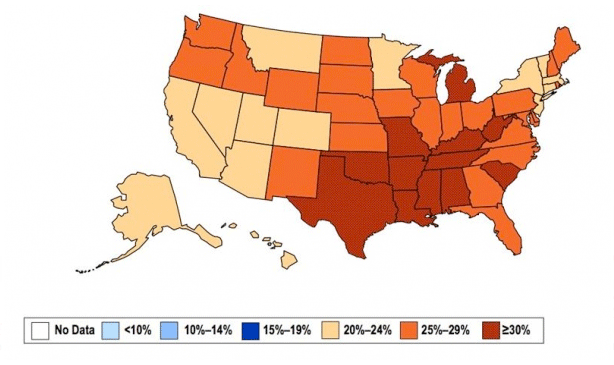
US obesity rates in 2010.
And this is very worrisome, both for the health of our country, but in some ways for the economic and social vitality of our country. And the most frightening statistic I’ve heard in the last few months was about the fact that we are now projecting that something like 11 percent of all the people in America having Body Mass Indexes over 40, which means the equivalent of 100 pounds overweight or more.
We cannot deal with this epidemic medically - we’ve got to look at upstream issues. How do we help people eat and afford healthier diets, and how do we build physical activity into their lives, because if we don't turn this around, the costs of this epidemic will crush us.
CURWOOD: So what do we need to do about designing the places where we live? Where are the healthiest places to live?
JACKSON: I worked on a Public Broadcasting video series and we visited a whole series of cities. A couple of my favorites were: Boulder, Colorado… pretty much everyone in Boulder can go about their daily lives, meet their daily needs on a bicycle or on these lovely walking trails, and they’re a way to socialize. Another city I liked very much was Charleston, and mayor Joe Riley, who worked very hard to preserve both the character and the walkability and the downtown life of Charleston, has done a terrific job there as well.
CURWOOD: So, let me add this all up – the way that we live is contributing to an obesity epidemic, to depression, to asthma. You’re setting about to try to change that - but progress so far seems pretty slow to me.
JACKSON: People are already voting with their feet and with their pocket book. About 56 percent of people looking to buy a home in America today want something in a walkable neighborhood. Older folks, the baby-boomers, don’t want to be in distant suburbs, particularly when they lose their driving privileges as they age… and young people, the millennials, have looked at the rat-races that their parents were leading and don't want to duplicate it.
They’re being pulled into urban areas that have lively social scenes and have places where people can walk and play. Our cities are realizing that for them to be economically viable, they’ve got to bring in bright, young people - and that’s where the bright, young people want to be - in places that meet their physical, their social, their cultural, and intellectual needs.
CURWOOD: Early in your career you focused a lot on environmental contaminants, pesticides. And this month, September, 2012, is 50 years on from when Rachel Carson published her book Silent Spring. Tell me, how did Rachel Carson’s work influence your work - what do you think of Rachel Carson and her legacy?
JACKSON: Rachel Carson was remarkable. She brought about the first pesticide laws as she described the environmental impacts of DDT and a series of other chemicals we were using. I hope that if Rachel Carson were with us today, she wouldn’t say “Oh, I failed.” I think she would be very worried about the trajectory we are on.
Our current way of regulating chemicals, frankly, doesn’t work very well at this point. We spend 20-25 years researching a chemical and then when we discover ‘Oh, it’s a carcinogen’ ‘Oh, it causes this reproductive hazard,’ the manufacturer changes a chlorine for a bromine and puts a new version out on the market and all over again we have to start this. And so, the toxic substance control laws really need to be brought into the 21st century.
CURWOOD: Dr. Richard Jackson is Professor of Environmental Public Health at the School of Public Health at UCLA and winner of this year’s Heinz Award for the Environment. Thank you so much, Dr. Jackson!
JACKSON: It's a pleasure to talk to you, Steve!
Related link:
Heinz Awards
[MUSIC: Jimi Hendrix “The Burning Of The Midnight lamp” from Electric Ladyland (Legacy Records 2009 Reissue)]
CURWOOD: Just ahead – Silent Spring at 50. Stay tuned to Living on Earth!
[CUTAWAY MUSIC: Jimi Hendrix: Cat Talkin To Me” from West Coast Seattle Boy: The Jimi Hendrix Anthology (Legacy Records 2010).]
A Look Back at Rachel Carson

Rachel Carson (US Fish and Wildlife Service)
CURWOOD: It’s Living on Earth, I'm Steve Curwood. Fifty years ago this month saw the publication of one of the most influential books of the last century - Silent Spring by Rachel Carson.
RACHEL CARSON: We spray our elms, and the following springs are silent of robin song. Not because we sprayed the robins directly, but because the poison traveled, step by step, through the now-familiar elm-leaf-earthworm-robin cycle.
CURWOOD: A gifted writer from childhood, Rachel Carson trained as a marine biologist, and worked for years for the US Fish and Wildlife Service. In 1951 she wrote the best seller "The Sea Around Us" - which earned her enough royalties to buy a summer home on Southport Island in Maine.
There she met a teacher, Dorothy Freeman, and the two women became fast friends, sharing experiences and exchanging about a thousand letters over the next 12 years. Well, in 1995 Freeman's granddaughter, Martha, published some of those letters in a book called "Always, Rachel". She came into our studios to share her book and her memories of the famous author.
On this anniversary of Silent Spring, we revisit that recording. Martha Freeman told us that her grandmother and Rachel shared a passion for birds, cats, classical music and the ocean.
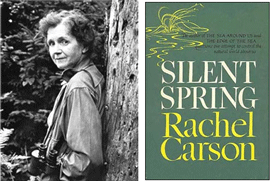
Rachel Carson’s ground breaking work “Silent Spring” was published in September of 1962.
FREEMAN: I remember them as my guides to that beautiful place, to tide-pooling on Rachel's beach, to walking in the woods with the both of them, to having them just want me to experience the beauty of the sun through the trees, the salt in the air, the moss under feet, the little starfish and periwinkles in tide pools.
CURWOOD: These letters go through so many aspects of Rachel Carson's life and your grandmother's life. And there's a section that they talk about the creation of Silent Spring itself. I'm wondering if you could take us back to February 1st, 1958, when Rachel first tells your grandmother Dorothy about her idea for the book.
FREEMAN: Sure. Rachel writes, "About the book. It was comforting to suppose that the stream of life would flow on through time in whatever course that God had appointed for it. Without interference by one of the drops of the stream, man, and to suppose that, however the physical environment might mold life, that life would never assume the power to change drastically or even destroy the physical world.
These beliefs have almost been part of me for as long as I have thought about such things. To have them even vaguely threatened was so shocking that as I have said, I shut my mind, refused to acknowledge what I couldn't help seeing. But that does no good, and I have now opened my eyes and my mind. I may not like what I see, but it does no good to ignore it.
And it's worse than useless to go on repeating the old eternal verities that are no more eternal than the hells of the poets. So it seems time someone wrote of life in the light of the truth as it now appears to us, and I think that may be the book I am to write. Oh, a brief one, darling, suggesting the new ideas, not treating them exhaustively. Probably no one could; certainly I couldn't."
CURWOOD: From these letters, Martha, what is it about Rachel Carson, what was it about her character, her being, that allowed her to have this insight that no one else, up until her time, had?
FREEMAN: My feeling is that part of Rachel's genius was that her understanding derived from the point at which intellect and intuition, thinking and feeling intersect in a person. That she brought a wealth of scientific knowledge to bear on the problem, but also her deep feelings for nature, her real understanding of the lives of the sea creatures on her beach, of birds and fish, and her love for nature, and her love for people as part of nature, too.
CURWOOD: Now your grandparents were at first quite worried about this project of Rachel's. It was called the poison project.
FREEMAN: The poison book.
CURWOOD: The poison book. Can you tell us about their thoughts?
FREEMAN: Well, my grandfather worked for a large agricultural feed company; he was an executive. And so he was, they were concerned for her personally, that the message she was going to deliver would not be taken kindly by some pretty powerful interests in this country. And they wanted the message out but they were concerned that their friend Rachel was going to be the one to take it on.
CURWOOD: There was this enormous backlash against the publication of Silent Spring. Indeed, as your grandfather worried and your grandmother worried, there was outcry from the chemical companies and other people as well. Did Rachel and your grandmother write much about this at all?
FREEMAN: They did write, yes, they did write some about it, and it's amazing. Rachel was just not daunted by the attacks. They did not seem to throw her off-center. She just replied to them. She kept getting her message out in speeches, in articles. She just was very certain of what she understood.
CURWOOD: All right; let's hear a bit from some of these speeches. Now here's a talk that she gave to the National Women's Press Club in 1962.
CARSON: Now, I don't want to belabor the obvious, because anyone who has really read the book knows that I do favor insect control in appropriate situations. That I do not advocate the complete abandonment of chemical control. That I criticize modern chemical control not because it controls harmful insects but because it controls them badly and inefficiently. And because it creates many dangerous side effects in doing so.
I criticize the present methods because they are based on a rather low level of scientific thinking. We really are capable of much greater sophistication in our solution to this problem.
CURWOOD: The years in which she was writing Silent Spring, 1958 to 1962, were trying for both Rachel Carson and Dorothy Freeman. Ms. Freeman's mother was dying and her husband's health was beginning to fail. Martha Freeman says illness and death were also ever-present for Carson.
FREEMAN: For Rachel, Rachel's elderly mother also lived with her and her health began declining in that period. Rachel's niece died, a woman that Rachel had supported throughout her life, and Rachel adopted the niece's 5-year-old son. So Rachel was taking care of a youngster and an elderly mother in ill health at the time when she was trying to write Silent Spring, and also discovering that she herself had cancer.
CURWOOD: The book is finally done, she sends off what will be printed in The New Yorker. And she gets a letter back from The New Yorker magazine editor, William Shawn. And the letter that she writes to your grandmother about the acceptance from Shawn and what it all meant to go through this is very powerful. I'm wondering if you could read that for us now.
FREEMAN: Yeah, I'd be happy to. There are 2 names mentioned in here that I should clarify for people. One is Roger, her grand-nephew who is now her adopted son; and Jeffy, her cat. So Rachel writes to my grandmother, "I longed so for you last night to share my thoughts and feelings. It was odd. I really had not been waiting breathlessly for Mr. Shawn's reaction. Yet once I had it, I knew how very much it meant to me.
You know I have the highest regard for his judgment, and suddenly I knew from his reaction that my message would get across. After Roger was asleep, I took Jeffy into the study and played the Beethoven Violin Concerto, one of my favorites, you know. And suddenly, the tensions of 4 years were broken and I got down and put my arms around Jeffy and let the tears come.
With his little warm, rough tongue, he told me that he understood. I think I let you see last summer what my deeper feelings are about this. When I said I could never again listen happily to a thrush song, if I had not done all I could. And last night, the thoughts of all the birds and other creatures, and all the loveliness that is in nature, came to me with such a surge of deep happiness that now I had done what I could. I had been able to complete it. Now it had its own life. And those are the thoughts I would have shared had you been here. I wish you were."
CURWOOD: Ultimately, Congress, President Kennedy acknowledged Carson's ideas and they had great staying power over these last 30 years. And by the spring of '63 it was pretty clear, at least to your grandmother, and she wrote to Rachel to tell her so. I'm wondering if you could read from this letter of May 15th. And bearing in mind now that Rachel's pretty ill by this time, that her health is going down pretty fast.
FREEMAN: My grandmother wrote to Rachel, "A thought struck me last night, that suddenly the dear old Sea Around Us had been displaced. I never dreamed that could ever happen. That now I think your fame will rest on Silent Spring.
When people talk about you, they'll say: Oh yes, the author of Silent Spring. For I suppose there are people who never heard of The Sea Around Us, strange as that may seem to us. But surely I doubt if there is a household in this country where your name is unknown. How could it be from Peanuts to CBS Reports not to mention all the lawns which have become a major concern now, what to do for crabgrass because Rachel Carson says.
[BIRD-SONG - WOOD THRUSHES AND ORIOLES]
Oh darling, the wood thrushes and orioles have been sounding your praises while I've been writing. This spring is far from silent, and because of you there is a chance now that future springs need not be. Bless your heart. I don't suppose you can put into words how you feel about all this. So I shall just try to feel with you."
CURWOOD: Martha Freeman reading from a letter her grandmother Dorothy wrote to her friend Rachel Carson, collected in the book, "Always, Rachel", from a broadcast on Living on Earth in 1995.
“Silent Spring Turns” 50
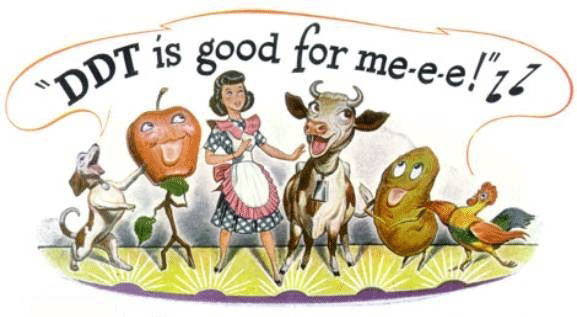
CURWOOD: Well, it's hard to exaggerate how influential Silent Spring has proved to be in the half century since it was published. With Rachel Carson’s death so soon after publication, her editors had to look to someone else to write a follow up in 1970, and that man was Frank Graham.
Frank Graham has been the field editor for the Audubon Magazine for the last 40 years and in a volume called Since Silent Spring he documents how pesticide legislation changed in the wake of Rachel Carson’s work. He joins us now on the line to recall those times - welcome to Living on Earth!
GRAHAM: Nice to be here Steve!
CURWOOD: How widely used were chemicals like DDT back in the 1940s and 50s, before Rachel Carson published Silent Spring?

An advertisement for DDT reads “DDT kills … destructive pests and is a benefactor of all humanity.”
GRAHAM: The use was not only on farms, but I think what began to get people very much concerned about it, was the fact that it was also in the towns and neighborhoods. There used to be these spray trucks that would come around especially with the onset of the Dutch Elm disease and other problems with leaf eating insects.
And these trucks would come along and you could see children following the spray trucks down the street, it was kind of like seeing the fire engines come into your neighborhoods. So, everything was being drenched with it. People on University campus would see and would notice that birds were practically just dropping out of the trees dead.
CURWOOD: So, in the US, how would you say that pesticide use has changed since Rachel Carson’s book came out?
GRAHAM: Pesticide use has increased. Of course, since her time, there are more people in the world, there are more areas to use pesticides in. I think we use over a billion pounds a year in the US alone. We all have small amounts of pesticides in our bodies, much research has suggested that there might be, for instance, long-term reproductive effects in males of the human species. And there are enough warning signs going up that there are perhaps lots of problems ahead of us.
CURWOOD: So what do you think needs to happen now in terms of pesticide use?
GRAHAM: One of the interesting things about Carson’s book was that in the end she had a chapter on “Taking the Other Road” in which she investigated, seriously, alternatives to pesticide use. And I think in recent years a lot of that has been attempted and done with a considerable amount of success in some areas, for instance, under the name integrated pest management, where pesticides are used to some extent but in much lower doses than were used originally, but with other techniques such as predator insects or parasites against the pest organisms.
CURWOOD: So, when Silent Spring came out, is it fair to say that it was the first hard look at these chemicals and their potential dangers for the public?

DDT was widely sprayed on soldiers in World War II. (Wikimedia Commons)
GRAHAM: Yes it was. Most people were completely, I think, unaware of that. Almost all of the other materials that they came up with before that was positive about DDT and some of those other chemicals. So, what Carson’s idea was just to… she began to hear stories, and she went around and talk to other scientists and so on - and no one was really willing to stick their neck out.
She did not want to write this book herself. She was a very private person, she knew that the consequences would be a serious attack on her. She actually spoke to several other people trying to get them to write the book, but no one else was either qualified or willing to take it on.
CURWOOD: It almost goes without saying that Rachel Carson’s book did not cheer the chemical industry.
GRAHAM: No, it was a rather serious attack against them.
CURWOOD: What kinds of things did they do and say?
GRAHAM: Well, there was a tremendous public relations attack on Carson. She was accused of hysteria… of being a sort of ‘high priestess of nature,’ she was called. I think she was ridiculed also as a woman - you know, sticking her nose into some area where she wasn't really invited.
I remember at a federal meeting, one of the entomologists got up and said, ‘Rachel Carson should not be concerned about something like this - after all, she’s a spinster, so these genetics don’t concern her.’ The reproductive losses and so on. There was a lot of snide and actually vicious comments - they called her all kinds of names, including, I think the most scathing one was that she was a ‘bird watcher.’
CURWOOD: Oh my!
GRAHAM: So…
CURWOOD: We know about them, don’t we?
GRAHAM: (Laughs.) We do!
CURWOOD: Today we hear a lot about scientists feeling intimidated by industries that don’t like their results. How do you think the atmosphere for scientists today compared to what Rachel Carson encountered 50 years ago?
GRAHAM: Well, I think there’s a peculiar sameness about. I know that there are several scientists who’ve done studies on the global climate change have come under severe attack from a lot of these people. One man apparently had somebody who laid a dead rat, on his doorstep and things like that. They’ve come under a lot of pressure.
CURWOOD: So how do you sum up the importance of Rachel Carson’s Silent Spring for the environmental movement for this nation?
GRAHAM: I think that it had a great effect on some areas, perhaps beyond pesticides. It made people aware of air pollution, water pollution. I think it certainly led to the creation of the EPA and other agencies like that - it just opened up the whole issue of pollution.
CURWOOD: Frank Graham is an editor of the Audubon Society and wrote the follow-up to Rachel Carson’s work entitled “Since Silent Spring.” Thanks so much, Frank, for taking this time.
GRAHAM: OK, Thank you, Steve!
Related links:
-
- An article by Frank Graham in Yale Environment 360 about the ongoing assault of science
[MUSIC: Marc Johnson/Eliane Elias “Inside Her Old Music Box” from Swept Away (ECM Records 2012).]
CURWOOD: Coming up – how some otherwise highly annoying dogs are helping to conserve nature. Keep listening to Living on Earth!
[CUTAWAY MUSIC: Lee Ritenour: “Fat Albert Rotunda” from Rhythm Sessions (Concord Music 2012).]
ANNOUNCER: Support for Living on Earth comes from Breckenridge Capitol Adivsors, sustainable approach to fixed income investing www.breckenridge.com. The Grantham Foundation for the protection of the environment, supporting strategic communication and collaboration in solving the world’s most pressing environmental problems. The Gordon and Bette Moore Foundation and Gillman Ordway for coverage of conservation and environmental change. This is Living on Earth on PRI. Public Radio International.
Science Note: Synthetic Ambergris
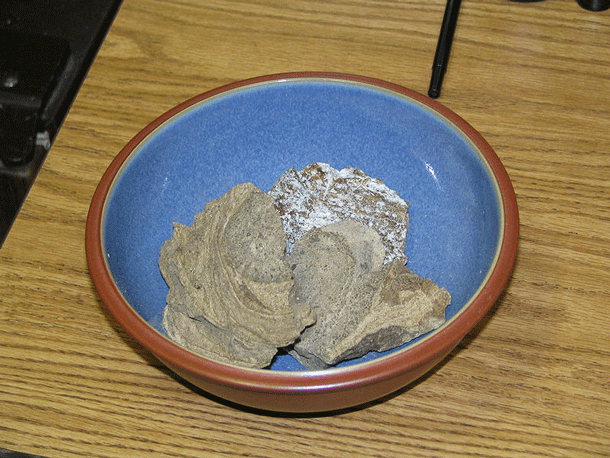
Ambergris has been a key ingredient in fine perfumes for centuries. (Peter Kaminski)
CURWOOD: It's Living on Earth - I'm Steve Curwood. Just ahead - the tale of a bird that fills a useful environmental role - yet looks weird and is widely despised. First this note on emerging science from Mary Bates.
[SCIENCE NOTE THEME]
BATES: For centuries, perfumers have relied on a substance with the poetic name of ambergris to help fragrances stay on people’s skin longer. But ambergris has less than poetic origins: it’s nothing more than vomit from sperm whales. Now scientists are closing in on a synthetic alternative that will leave whales out of the perfume-making business.
When whales consume sharp objects like seashells or squid beaks, their guts coat the items in a protective, sticky substance. They regurgitate the waxy, gray balls and the gobs wash ashore – on coasts from the Bahamas to Australia, where harvesters manually collect them.
Collecting ambergris is time-intensive and there are fears that demand may encourage poaching of the endangered whales, which have intestines full of the stuff. But now, researchers from the University of British Columbia have identified a gene in balsam fir trees that could lead to the production of synthetic ambergris.
The gene enables the fir tree to produce a compound called cis-abienol, which has properties similar to ambergris. Scientists transferred the gene into yeast cells, which were then able to produce the compound quickly and efficiently.
This technique could produce an ambergris alternative that’s less expensive and more sustainable. And the fragrance industry is betting that ambergris by any other name will smell just as sweet. That’s this week’s Note on Emerging Science, I’m Mary Bates.
[SCIENCE NOTE THEME]
Related link:
Abstract in the Journal of Biological Chemistry
Marabou Stork
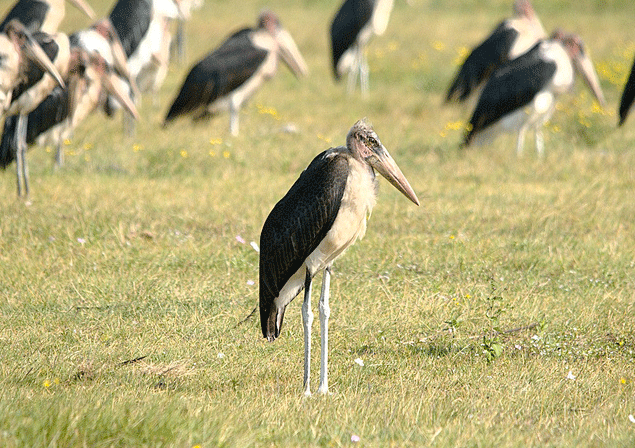
A flock of Marabou Storks (Photo: Sergey Yeliseev)
CURWOOD: Urban and natural landscapes rub against each other the world over. Often, they leak into each other. And when they do, natural places get sliced up and thinned out and cities get overrun by the unwanted. Reporter Ari Daniel Shapiro has a story from Uganda about a particularly pesky bird -- though exactly how pesky depends on whom you ask.
SHAPIRO: Before I get into why a lot of people in Uganda despise Leptoptilos crumeniferus, or the Marabou stork…I need to tell you what these birds look like. I’m at Makerere University, in Kampala. Lilian Twanza is a graduate student here, and she studied the Marabou storks as an undergrad. Twanza points to the sky.
TWANZA: Wait, can you see them?
SHAPIRO: Oh, yeah, they’re all up there. Look at that. There must be 20 birds up there!
SHAPIRO: Even from a distance, they’re huge. Wingspans of up to 9 or 10 feet. They’re dark and graceful. But up close is a different matter.
TWANZA: Someone once said they have the typical look of a dirty old man.
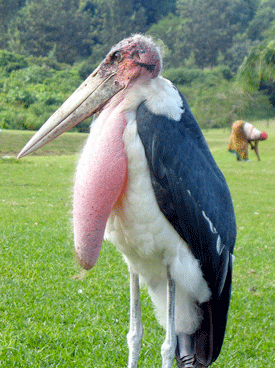
Marabou Stork (Photo: kibuyu)
SHAPIRO: Indeed. Twanza’s brought me to within spitting distance of several Marabous. They’re sitting above us, in the branches of an albizia tree on the edge of a campus parking lot.
The storks are bald. The head and neck are pinkish without feathers. Long pouches droop beneath their necks like fleshy tube socks. A bright red bump swells from the nape. The rest of the bird is covered in black and white feathers. And beneath one of the storks in the tree – a couple of fuzzy white heads.
TWANZA: Just two heads down there. When it gets very hot, the adult stretches out its wings, just providing shade for the young one. You can’t tell whether it’s the male or female. They both parent in turns.
SHAPRIO: The adult coos at the babies. And the babies coo right back.
[SOUNDS OF COO-ING MARABOU STORKS]
TWANZA: Marabous are monogamous. They pair once for life.
SHAPIRO: For life?
TWANZA: Yes.
SHAPIRO: Physical appearances aside, this portrait of Marabou family dynamics might seem rather lovely. But I haven’t said what these storks feed on. They’re scavengers. In the wild, the storks gobble up carcass scraps, and feces. That’s why they’re bald – otherwise the head feathers would get clotted up with blood and grime. They also eat small, live animals.
TWANZA: Fish, rats, snakes, frogs.
SHAPRIO: But in a big city like Kampala, the Marabous have a lot more to choose from.
TWANZA: Mainly what attracts them is garbage. In Africa, garbage collection is not good so the garbage stays lying around.
SHAPRIO: Along with all the garbage, Kampala has three abattoirs, or slaughterhouses, and the fleshy scraps get chucked out the back. The storks wolf those down too and either regurgitate them for their young or carry the pieces back whole. All this food means more of the baby birds are surviving into adulthood. The result is a population explosion.
They’re one of the first things I saw after arriving at the airport. They sit atop the poles lining the highways. They circle the air above the city. And when they do settle down, into a tree above a parking lot, say, that’s when the real mischief starts. The ground beneath our feet is splattered with white.

(Photo: M Kuhn)
TWANZA: Those are the droppings. It’s a bit acidic.
SHAPIRO: When the droppings land on a car, it dissolves the paint right off.
TWANZA: So if you keep leaving your car under the shade, wanting protect it from the sun, the Marabous will spoil it. And then when people are passing, it can drop on you also – on your clothes, in your hair.
SHAPIRO: The droppings corrode rooftops and trees. The birds even end up targeting themselves.
TWANZA: The legs of the Marabou stork are not characteristically white. That’s a coating of their own droppings.
SHAPIRO: Twanza says that Ugandans are beyond frustrated with these storks. They’ve taken matters into their own hands.
TWANZA: If you had been here maybe, like, on Monday, you would have seen the tree that had been cut and the young had fallen down and died there.
SHAPIRO: Why did they cut the tree?
TWANZA: Usually they use another excuse so that the environment people don’t come, complaining a lot. They say, “We cut the branches because of the electric wires.” But generally, they want to get rid of the storks.
SHAPIRO: Once a baby stork’s fallen to the ground, the parents stop taking care of it.
TWANZA: The young ones, some of them just get broken limbs so they stay there and die from hunger or other animals destroying them.
SHAPIRO: It doesn’t fix the problem, though. The following year, the Marabou pair will breed again and hatch another two or three chicks. Twanza has a different solution.
TWANZA: The only recommendation is getting rid of garbage.
SHAPIRO: Less food means fewer young survive. Gradually, the Marabou numbers will decline. Twanza’s seen it happen on campus. When she first started studying Marabou storks in 2008, she counted 5000 storks filling up the trees and rooftops of the university. Now, after a few years of improved, daily, trash collection, the numbers are down to 2000.
But Twanza isn’t expecting similar improvements in sanitation throughout Kampala. And yet, at the same time, she recognizes that the birds are important, and even good for Uganda.
TWANZA: They get rid of everything we don’t want. We want them alive – they are part of the ecosystem.
SHAPIRO: Marabou storks exist alongside an ecology that humans have created, just like cockroaches or rats. People tend not to like those animals either. But actually – all those storks sitting in the trees, or the rats scurrying down an alley – they’re really just an indication of our own habits. Habits that could use some cleaning up.
For Living on Earth, I’m Ari Daniel Shapiro.
CURWOOD: Our story on Marabou Storks comes from the series One Species at a Time, produced by Atlantic Public Media with support from The Encyclopedia of Life. For photos - check out our web site - loe.org.
[MUSIC: Jimi Hendrix “Burning Desire” from West Coast Seattle Boy: The Jimi Hendrix Anthology (Legacy records 2010).]
Conservation Canine

Casey is a 15 pound conservation canine. (Conservation Canines)
CURWOOD: From hunting to pulling sleds to leading the blind, throughout history dogs have performed a variety of jobs for their human companions. Now the Conservation Canines program at the University of Washington is putting man’s best friend to work for science.
Joining us from the University of Washington is the founder of Conservation Canines program and director of the University’s Center for Conservation Biology, Professor Samuel Wasser. Professor, welcome to Living on Earth.
WASSER: Thank you, glad to be here!
CURWOOD: So, tell us a bit about these canine conservationists. What role do these dogs play in scientific research?
WASSER: Well, essentially they are an extremely efficient way of acquiring samples. Most of the samples we use come from an animals feces or scat, and that’s because it’s loaded with a variety of physiologic and genetic measures. So, the dogs allow us to sample large bits of wilderness and also to sample multiple species often at the same time.
CURWOOD: What gave you the idea to use dogs in this way in the first place?
WASSER: Well, we wanted a method to sample animals according to their distribution in the wilderness. And one of the problems with feces is that some animals may use scat to mark their territory, which makes their scat more conspicuous and easier to find.
After looking at a number of different kinds of detection dogs: dogs that detect bad guys, dogs that are hunting narcotics, bomb dogs… it became pretty clear that the narcotics dogs are kind of the perfect models for this system, because what these are, are very high reward-driven dogs, once you train the dog that it gets its reward from detecting the sample, it really will do anything it can to get its reward.
So, in our case, our dogs have an incredible play drive for a ball. They are so focused, that, if they know you’ve got the ball, and you throw the ball, nothing in its way will stop it. What’s really nice about this is that you can transfer this incredible drive into finding samples because the dog is so obsessed. Once it smells a sample and knows its going to get the reward from it, it will work tirelessly to find it.
CURWOOD: And once it finds the sample, you can then subject it to all this DNA testing and such to determine exactly what the animal is and what its other habits are?
WASSER: We can use the DNA in the samples to actually figure out how many animals of each species there are in the wilderness. We know the location of those samples, so we not only know how many individuals there are, but where they are located, what areas they are avoiding. And then we can get the physiological measures from those same samples again and see if they are in areas that they really prefer, are they in better physiological health than when they’re in areas that they’re avoiding.
And in doing so it allows us to see what are the pressures facing these animals, and as those pressure change, how does it affect their physiological health and well being.
CURWOOD: Wow, that’s a lot to learn from a bit of poop!
WASSER: It’s fantastic, actually.
CURWOOD: Where do your dogs come from?
WASSER: I mentioned that the dogs have an extremely high ball drive. One of the things that happens to these kinds of dogs is that when people get them as pets, they find out after the animal gets to be a year and a half, two years old, that they simply can’t keep it because it will just do anything for its ball and it’s just relentless - it just won’t stop.
So people end up giving those dogs to the pound or shelters hoping that someone else will adopt them. But the problem is that those dogs are so wild that nobody wants to adopt them. We go through the pounds and we look for the dog that has this completely obsessive drive for the ball – that nothing else matters when it sees the ball – and that’s the animal that we choose for our work.

The ideal conservation canine is intensely focused and has an insatiable urge to play ball. (Conservation Canines)
CURWOOD: I understand that your conservation canines are working with the Jimez mountain salamander. How are they helping to save this salamander?
WASSER: Well, the Jimez mountain salamander is endangered. We have been working with the Nature Conservancy and the US Fish and Wildlife Service to find these salamanders in their remote wilderness habitat. They’re very small, they’re just a few inches long, and they’re no thicker than a pencil and very cryptically colored. So they’re very difficult to find, and when they’re above ground, it’s only for this short period of time in the monsoon when there’s good rain then you need to be able to locate them quickly. So, our dogs have been trying to help the Nature Conservancy and the US Fish and Wildlife Service to locate these lizards [ED - THEY ARE CORRECTLY AMPHIBIANS, NOT LIZARDS] in their remote habitat.
CURWOOD: Now, I understand that your canine conservation program is working in the Alberta tar sands, it’s a very controversial area - this business of extracting oil from tar sands. What do these dogs do up there?
WASSER: For four years, we brought dog teams into the tar sands. Now, we went through and we monitored the impacts of the oil development on the caribou, the moose, its competitor, deer, and their predator, the wolf, over the period when the oil companies were there, which is in the winter when the ground is deeply frozen, it’s about minus 10 Celsius and the snow is two feet deep.
And the reason it was important to know their impacts on the caribou was because the caribou were believed to be going extinct in Alberta within the next two decades. We collected samples over the landscapes and the four dogs in the ten weeks we were there got about 1500 samples, which allowed us to get accurate population estimates of the caribou, moose and wolf, and allowed us to see their distribution across the landscape, and allowed us to see their physiological health and how this was changing with the number of oil workers on the landscape.
CURWOOD: And the mission was to find out whether or not the caribou were endangered and you found…?
WASSER: The first thing we found was that the caribou were not declining anywhere near as quickly as government projections had implied. There were well over twice as many caribou in the area as the government projected.
CURWOOD: How then did this affect government policy?
WASSER: The government was arguing that the best way to deal with the situation is to remove 60 to 80 percent of the wolves on the landscape. Well, what we showed was that the wolf was actually taking very, very few caribou. They were really heavily focused on deer. If they took 60 to 80 percent of the wolves out of the population, the deer would undergo a population explosion in the area. And deer eat everything. They also bring with them a number of diseases like chronic wasting diseases, a variety of parasites that can jump to caribou and potentially really cause great harm to the ecosystem.
CURWOOD: So, if wolves aren’t the problem, then what is?
WASSER: The real problem appears to be food. In the winter time, the vast majority of caribou are pregnant, and these pregnant females are eating almost entirely lichen. The lichen is very, very rich in glucose, and that is the primary food that a fetus consumes when it is developing. So that told us that lichen was the key nutrient that we needed to protect and that variation in the amount of lichen transfers to variation in pregnancy health. One of the things that we also found was that the soil conditions that lichens grow in are the same kinds of soil conditions that are good for building roads.
CURWOOD: Sandy, and smooth, and even?
WASSER: Yes. And what that implied was that the number of people on the landscape, and therefore the number of people using those roads could be preventing the caribou from accessing those lichen, even though the lichen was there. They were afraid to go there because there were so many people on the landscape, and people to them are also viewed as a predator.
CURWOOD: So, the answer there was to ask people to stop spooking the caribou.
WASSER: Right. And, of course, we’re talking about an area where there’s billions of dollars at stake here, so you can’t just say ‘just stop’ because that’s not going to happen. But we were able to make recommendations about how they could work on the landscapes that would minimize the impact on the caribou, and there are two really important aspects that we are trying to get them to implement.
One is that instead of extracting oil very diffusely over the entire landscape, that if they were able to concentrate their activity at any point in time in a certain area, work that area and then move to a new area, the caribou would be much better able to move around in areas that they could still access lichen.
And the second recommendation is to be more thoughtful about where they put these high-use roads. Now, giving them recommendations is one thing. The nice thing that’s happening is that the oil companies are coming to us and saying: OK, let’s get together and think about what is practical, what is not, and how can we best move forward in a manner that is going to put the animals at less risk. We’ll see what happens.
CURWOOD: So, how much do your dogs enjoy this work?
WASSER: Huh. They love what they do! I mean, think about it, you’re dealing with a dog that is just a maniac for its ball and all day long it’s running through the woods, smelling poop and getting a ball reward. I mean, what could be better if you are a dog?
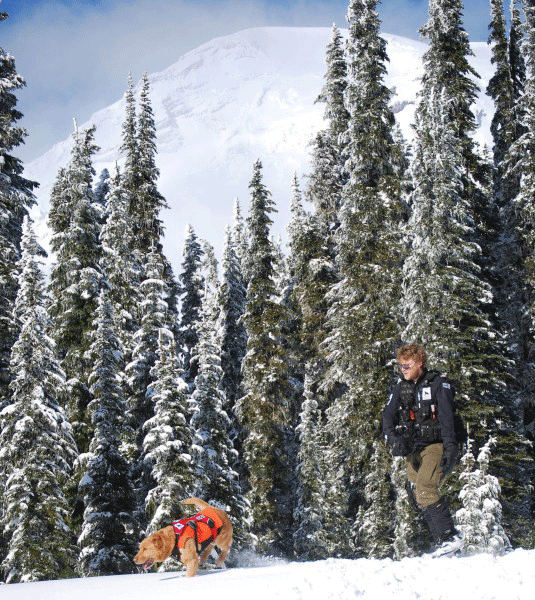
(Conservation Canines)
CURWOOD: Samuel Wasser is professor of conservation biology and founder of the Canine Conservation Program at the University of Washington. Thank you so much, sir.
WASSER: Thank you, it’s my pleasure.
[MUSIC: Dave Douglas “Dog Star” from Moonshine (Koch Records 2008).]
[EERIE SOUNDS]
CURWOOD: We leave you this week at the bottom of the world.
[SOUNDS CONTINUE AND BUILD]
CURWOOD: That unearthly sound is made by a Weddell Seal; a large seal that can dive almost two thousand feet deep under Antarctic ice, chasing the squid, fish, crab and shrimp that it eats.
[SOUNDS OF THE WEDDELL SEAL]
CURWOOD: Weddell seals typically stay down for about 15 minutes - though some dives last as long as an hour. These mournful cries are sometimes so loud, they can be heard above the ice. These Weddell seals were recorded in McMurdo Sound by Dr Ian Stirling for the British Library CD: Sounds of the Deep.
[EARTH EAR: “Weddell Seal” from Sounds Of The Deep: An Exploration Of Life In Our Seas The British Library Sound Archive 2007).]
CURWOOD: Living on Earth is produced by the World Media Foundation. Bobby Bascomb, Helen Palmer, James Curwood, Meghan Miner, Gabriela Romanow and Sammy Sousa all have a hand in making our show, and so does our intern Emmett Fitzgerald. Jeff Turton is our technical director. Alison Lirish Dean composed our themes. You can find us anytime at L-O-E dot org - and check out our facebook page - it’s PRI’s Living on Earth. I'm Steve Curwood.Thanks for listening!
ANNOUNCER: Funding for Living on Earth comes from the National Science Foundation, supporting coverage of emerging science. And Stonyfield Farm, organic yogurt and smoothies. Stonyfield invites you to just eat organic for a day. Details at just eat organic dot com. Support also comes from you, our listeners. The Go Forward Fund and Pax World Mutual and Exchange Traded Funds, integrating environmental, social and governance factors into investment analysis and decision making. On the web at Pax World dot com. Pax World- for tomorrow.
ANNOUNCER 2: PRI Public Radio International.
Living on Earth wants to hear from you!
Living on Earth
62 Calef Highway, Suite 212
Lee, NH 03861
Telephone: 617-287-4121
E-mail: comments@loe.org
Newsletter [Click here]
Donate to Living on Earth!
Living on Earth is an independent media program and relies entirely on contributions from listeners and institutions supporting public service. Please donate now to preserve an independent environmental voice.
NewsletterLiving on Earth offers a weekly delivery of the show's rundown to your mailbox. Sign up for our newsletter today!
 Sailors For The Sea: Be the change you want to sea.
Sailors For The Sea: Be the change you want to sea.
 The Grantham Foundation for the Protection of the Environment: Committed to protecting and improving the health of the global environment.
The Grantham Foundation for the Protection of the Environment: Committed to protecting and improving the health of the global environment.
 Contribute to Living on Earth and receive, as our gift to you, an archival print of one of Mark Seth Lender's extraordinary wildlife photographs. Follow the link to see Mark's current collection of photographs.
Contribute to Living on Earth and receive, as our gift to you, an archival print of one of Mark Seth Lender's extraordinary wildlife photographs. Follow the link to see Mark's current collection of photographs.
 Buy a signed copy of Mark Seth Lender's book Smeagull the Seagull & support Living on Earth
Buy a signed copy of Mark Seth Lender's book Smeagull the Seagull & support Living on Earth

